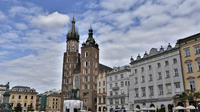Krakow Old Town Guided Walking Tour
Kraków, Poland
Rating: 







Trip Type: Walking Tours
Duration: 3 hours
See the beauty of the Old Town with its original Medieval street layout, marvelous architecture, and unique atmosphere that distinguishes Krakow from the rest of Poland. As the former capital of Poland, it has a rich history which is still visible in its architecture today.
More About This Activity All Walking Tours →
See the beauty of the Old Town with its original Medieval street layout, marvelous architecture, and unique atmosphere that distinguishes Krakow from the rest of Poland. As the former capital of Poland, it has a rich history which is still visible in its architecture today.Take the Royal Route - the highlight of the Old Town, which begins at St. Florian's Church in the northern part of the Medieval Old Town, continues along Floriańska, Grodzka, and Kanonicza Streets, and ends at Wawel Castle – the old residence of Polish monarchs, which was built in the 14th century. With a number of prominent historic landmarks on its way, The Royal Route is a true reminder of the golden age in Krakow's history.
See Wawel Hill; a 50m-high rock on the edge of the old town located on the bank of the Vistula River. On the top of the hill you’ll see the most important monument of Poland – Wawel Castle. The building is a mixture of Medieval, Romanesque, Renaissance, and Baroque style. Up until the 17th century the castle was the seat of the Polish Monarchy. One of the most important parts of the historical structure is the Cathedral, which is full of chapels, tombs and sarcophagi. While visiting Wawel Hill do not forget to enter the Royal Chambers and the Armoury. The cord in front of the Cathedral offers a beautiful view of the Sigismund Chapel with its gold covered roof.
Next it's St. Mary’s Basilica in Rynek Główny: The basilica was built in the 13th century in place of the previous one, which was destroyed during one of the Tartar invasions. Inside, you will find works of the most prominent artists in this region of Europe. The magnificent altarpiece by Veit Stoss and the polychrome paintings by Matejko, Mehoffer, and Wyspiański are only some of them.
St Peter and Paul’s Church on Grodzka Street 54 - The most important Jesuit church in the city. Although it was built in the first decades of the 17th century, it was rebuilt a few times and its current appearance is very different from the original one.
The Cloth Hall and the Underground Museum - This 14th century building was rebuilt after the conflagration in 1555 and serves as a splendid edifice of the renaissance. Some structures, such as the arcades or the central transepts, were added on in the late 1800s.
There will be also time on the tour for 1/2 hour coffee break (own expense) to discuss the social and economical situation of Poland, as well as funny stories, legends, customs and traditions.
See Wawel Hill; a 50m-high rock on the edge of the old town located on the bank of the Vistula River. On the top of the hill you’ll see the most important monument of Poland – Wawel Castle. The building is a mixture of Medieval, Romanesque, Renaissance, and Baroque style. Up until the 17th century the castle was the seat of the Polish Monarchy. One of the most important parts of the historical structure is the Cathedral, which is full of chapels, tombs and sarcophagi. While visiting Wawel Hill do not forget to enter the Royal Chambers and the Armoury. The cord in front of the Cathedral offers a beautiful view of the Sigismund Chapel with its gold covered roof.
Next it's St. Mary’s Basilica in Rynek Główny: The basilica was built in the 13th century in place of the previous one, which was destroyed during one of the Tartar invasions. Inside, you will find works of the most prominent artists in this region of Europe. The magnificent altarpiece by Veit Stoss and the polychrome paintings by Matejko, Mehoffer, and Wyspiański are only some of them.
St Peter and Paul’s Church on Grodzka Street 54 - The most important Jesuit church in the city. Although it was built in the first decades of the 17th century, it was rebuilt a few times and its current appearance is very different from the original one.
The Cloth Hall and the Underground Museum - This 14th century building was rebuilt after the conflagration in 1555 and serves as a splendid edifice of the renaissance. Some structures, such as the arcades or the central transepts, were added on in the late 1800s.
There will be also time on the tour for 1/2 hour coffee break (own expense) to discuss the social and economical situation of Poland, as well as funny stories, legends, customs and traditions.
« Go Back

